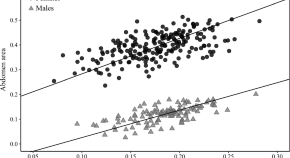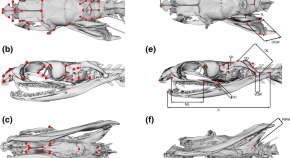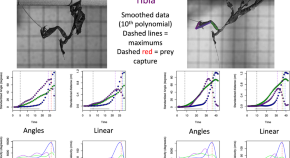
Collection
Special Issue: The ecological and evolutionary implications of allometry
- Submission status
- Closed
This special issue aims to collate articles that investigate the ecological and evolutionary implications of biological scaling. Allometry—the study of proportional growth of body parts, and the relationship of body size to an organism’s morphology, physiology and behaviour—is a fundamental influencer of ecological and evolutionary diversity. Approaches to the study of allometry vary from studies on scaling across an individual's development (ontogeny allometry), across individuals at the same developmental stage (static allometry), and across species (evolutionary allometry). Despite multiple definitions of allometry, it is evident that an organism’s body size is a critical factor in shaping its biology, and as such biological scaling underpins biological diversity.
It includes research, reviews, perspectives, and methodology articles that highlight the role of coordinated growth and body size in the context of evolutionary and ecological processes. We considered submissions across a wide range of taxa in areas including but not limited to sexual selection, organismal interactions and coevolution, behaviour, adaptation, metabolic scaling, biodiversity and life history.
Keep up with the latest Evolutionary Ecology content by signing up for Journal Alerts today!
Editors
-
Emma Sherratt
Dr. Sherratt is an evolutionary biologist with a fascination for the shape of life. Her research investigates macroevolutionary patterns of morphological diversity to understand the historical factors responsible for biodiversity. Dr. Sherratt specialises in applying morphometrics and digital imaging to characterise morphological variation and applies this to a wide range of metazoans, including reptiles and amphibians, mammals, beetles and molluscs.
-
Chrissie Painting
Dr. Painting is a behavioural ecologist and entomologist specialising in arthropod mating systems. She uses insects and arachnids to understand patterns of species diversity with a particular focus on the evolution of exaggerated animal traits including extreme mating behaviours, weapons and ornaments. Dr. Painting uses multiple approaches including field and lab experiments, molecular phylogenetics, statistical modelling and morphometrics, microCT xray reconstructions, digital imaging, and comparative evolution techniques. She tends to choose non-model species to address evolutionary problems.
-
Erin L. McCullough
Dr. McCullough is an evolutionary biologist and behavioural ecologist whose research aims to understand patterns of morphological and behavioural diversity. She specialises in studying the evolution of reproductive traits and uses diverse and integrated approaches to explore the evolutionary forces that give rise to biodiversity at different levels of biological organisation - from proteins to structures to populations to species.
Articles (18 in this collection)
-

-
Allometric patterns in phrynosomatid lizards and the implications for reconstructing body size for fossils
Authors
- Jaylin A. Knight
- David T. Ledesma
- Melissa E. Kemp
- Content type: Original Paper
- Published: 20 July 2022
- Pages: 561 - 590

-
Aggressive behaviour in the skyhoppers of the Australian Alps
Authors (first, second and last of 4)
- Giselle E. Muschett
- Christina J. Painting
- Kate D. L. Umbers
- Content type: Original Paper
- Open Access
- Published: 25 May 2022
- Pages: 663 - 681

-
Female preference for super-sized male ornaments and its implications for the evolution of ornament allometry
Authors
- Thomas C. Summers
- Terry J. Ord
- Content type: Original Paper
- Open Access
- Published: 14 May 2022
- Pages: 701 - 716

-
Size as a complex trait and the scaling relationships of its components across teleosts
Authors (first, second and last of 5)
- Laura R. V. Alencar
- Jennifer R. Hodge
- Samantha A. Price
- Content type: Original Paper
- Published: 05 May 2022
- Pages: 471 - 487

-
Correction to: Methods for studying allometry in geometric morphometrics: a comparison of performance
Authors
- Christian Peter Klingenberg
- Content type: Publisher Correction
- Open Access
- Published: 21 April 2022
- Pages: 735 - 736

-
Methods for studying allometry in geometric morphometrics: a comparison of performance
Authors
- Christian Peter Klingenberg
- Content type: Original Paper
- Open Access
- Published: 31 March 2022
- Pages: 439 - 470

-
Correction to: Deceived, but not betrayed: static allometry suggests female ornaments in the long‑tailed dance fly (Rhamphomyia longicauda) exaggerate condition to males
Authors
- Jessica H. Browne
- Darryl T. Gwynne
- Content type: Correction
- Published: 23 March 2022
- Pages: 737 - 739

-
Ontogenetic shift in diet of a large elapid snake is facilitated by allometric change in skull morphology
Authors (first, second and last of 7)
- M. Patterson
- A. K. Wolfe
- N. M. Warburton
- Content type: Original Paper
- Open Access
- Published: 14 March 2022
- Pages: 489 - 509

-
Ontogenetic allometry underlies trophic diversity in sea turtles (Chelonioidea)
Authors (first, second and last of 5)
- Ray M. Chatterji
- Christy A. Hipsley
- Marc E. H. Jones
- Content type: Original Paper
- Open Access
- Published: 05 March 2022
- Pages: 511 - 540

-
Variation in allometry along the weapon-signal continuum
Authors
- Erin L. McCullough
- Devin M. O’Brien
- Content type: Original Paper
- Published: 24 February 2022
- Pages: 591 - 604

-
Size variation, allometry and mating success in Aotearoa|New Zealand kelp flies (Coelopidae)
Authors
- Rebecca J. LeGrice
- Gregory I. Holwell
- Content type: Original Paper
- Open Access
- Published: 24 February 2022
- Pages: 683 - 700

-
Function predicts the allometry of contest-related traits, but not sexual or male dimorphism in the amazonian tusked harvestman
Authors (first, second and last of 4)
- Alexandre V. Palaoro
- Solimary García-Hernández
- Glauco Machado
- Content type: Original Paper
- Published: 15 February 2022
- Pages: 605 - 630

-
Deceived, but not betrayed: static allometry suggests female ornaments in the long-tailed dance fly (Rhamphomyia longicauda) exaggerate condition to males
Authors
- Jessica H. Browne
- Darryl T. Gwynne
- Content type: Original Paper
- Published: 07 January 2022
- Pages: 631 - 641

-
Ontogenetic changes in behavioral and kinematic components of prey capture strikes in a praying mantis
Authors
- Christopher E. Oufiero
- Content type: Original Paper
- Published: 25 October 2021
- Pages: 541 - 559

-
Correction to: Evolutionary allometry of sexual dimorphism of jumping performance in anurans
Authors
- Bryan H. Juarez
- Dean C. Adams
- Content type: Correction
- Published: 18 October 2021
- Pages: 741 - 742
-
Evolutionary allometry of sexual dimorphism of jumping performance in anurans
Authors
- Bryan H. Juarez
- Dean C. Adams
- Content type: Original Paper
- Published: 06 September 2021
- Pages: 717 - 733

-
Size and shape variation in the male dimorphic head weapons of an anthribid weevil (Hoherius meinertzhageni)
Authors
- Christina J. Painting
- Content type: Original Paper
- Published: 02 August 2021
- Pages: 643 - 662





